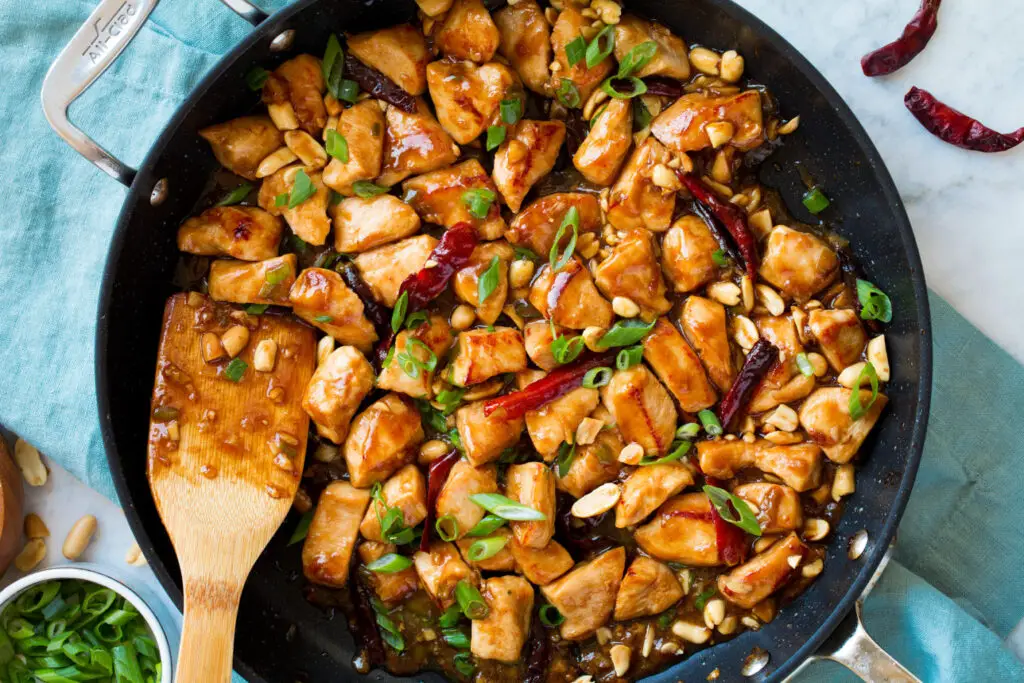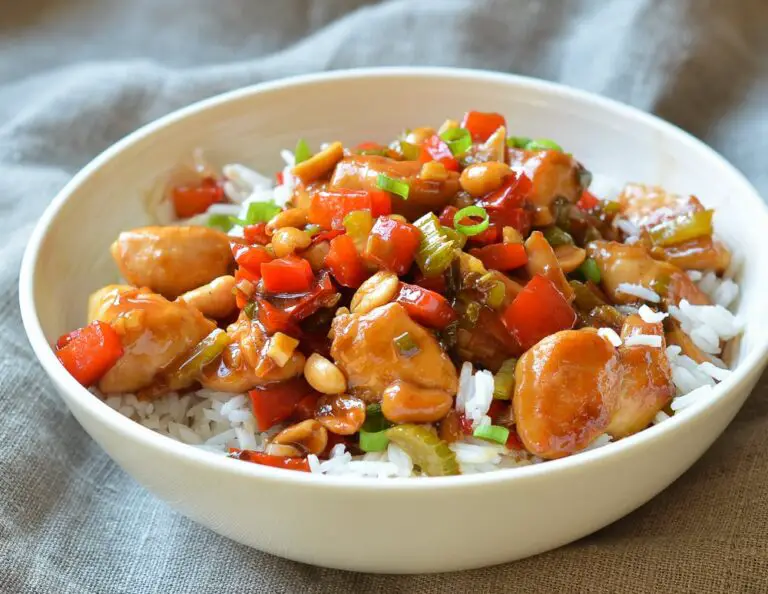Kung Pao Chicken Recipe: Authentic Sichuan Flavor with Easy Stir-Fry Steps
A Glimpse into History
Kung Pao Chicken, or “Gong Bao Ji Ding” (宫保鸡丁), traces its roots to Sichuan Province, China, during the late Qing Dynasty, around the late 1800s. The dish was named after Ding Baozhen, a respected governor and court official titled “Kung Pao.” A fan of spicy food, Ding’s preferred dish inspired chefs across Sichuan to emulate the iconic combination of tender chicken, fiery dried chilies, and crunchy peanuts, tossed together in a tangy-sweet soy-based sauce.
Originally a home-cooked delicacy, it quickly migrated from family kitchens to banquet halls and, eventually, across borders. With the growth of Chinese immigration and restaurant culture, Kung Pao Chicken made its way onto menus in Chinatowns from San Francisco to London. As the flavors adapted to local palates, variations emerged—but the heart of the dish remained unmistakably Sichuan.
Where It’s Most Loved Today
Thanks to its spicy kick and savory-sweet balance, Kung Pao Chicken has won over fans worldwide. It’s now a staple not only in China but also across continents. Here are the top 10 populations that frequently enjoy Kung Pao Chicken today:
-
China – The birthplace of the dish
-
United States – A cornerstone of Chinese-American takeout
-
Canada – Frequently featured in fusion Chinese cuisine
-
United Kingdom – A staple in Asian takeaway menus
-
Australia – Popular in multicultural food hubs
-
Malaysia – Incorporated into local hawker stalls
-
Singapore – Served with unique local twists
-
Philippines – Loved for its sweet-and-spicy appeal
-
Germany – Gaining popularity in urban Asian eateries
-
South Korea – Integrated into trendy Korean-Chinese restaurants
Whether you’re craving a bold Chinese stir-fry or looking to master a classic takeout favorite, this recipe will bring the heat—and the flavor—right into your kitchen.
🧰 What You’ll Need to Make Kung Pao Chicken
Essential Kitchen Tools 🍳
To recreate the irresistible flavors of homemade Kung Pao Chicken, having the right tools on hand will make the process smoother and faster. Here’s what you’ll need:
-
Wok or Large Frying Pan 🥘 – A wok ensures even, high-heat cooking essential for stir-fry.
-
Mixing Bowls 🥣 – For marinating chicken and preparing sauce components separately.
-
Measuring Spoons & Cups – Precision counts in getting the balance of salty, sweet, sour, and spicy just right.
-
Garlic Press or Fine Grater 🧄 – For releasing the intense aroma of fresh garlic and ginger.
These basic tools are likely already in your kitchen. But if you want to elevate your stir-fry game, consider a few optional upgrades.
Pantry Staples & Helpful Extras 🧂
A well-stocked pantry makes it easy to whip up Kung Pao Chicken anytime. Here’s what you’ll want to have ready:
-
Soy Sauce – Regular and dark soy sauce add depth and color.
-
Cornstarch – Essential for velvety chicken texture and sauce thickening.
-
Sesame Oil – A drizzle at the end adds nutty aroma and finish.
-
Rice Vinegar – Adds brightness and slight acidity to balance flavors.
Optional Tools 🛠️:
-
Meat Tenderizer – Especially helpful if using chicken breast to ensure tenderness.
-
Slotted Spoon – Ideal for transferring chicken out of the wok without too much oil.
🥕 Ingredients for the Best Kung Pao Chicken
Marinate the Chicken for Juicy Results 🍗
The secret to restaurant-quality Kung Pao Chicken lies in a short, flavorful marinade. This step ensures your chicken is tender, juicy, and packed with umami.
-
1 lb boneless chicken thighs or breasts, cubed (thighs for juiciness, breast for leaner option)
-
1 tbsp soy sauce
-
1 tbsp Shaoxing wine (or dry sherry as an easy substitute)
-
1 tsp cornstarch
Let the chicken marinate for 20–30 minutes while you prep the sauce and veggies. This step improves texture and helps lock in flavor.
💡 Pro Tip: If you’re short on time, a quick 10-minute marinade still works in a pinch—but aim for 30 minutes for best results.
Bold & Balanced Stir-Fry Sauce 🥢
This sweet, salty, and tangy sauce is the flavor backbone of your Kung Pao Chicken stir fry.
-
3 tbsp soy sauce
-
1 tbsp dark soy sauce (adds rich color)
-
2 tbsp rice vinegar
-
1 tbsp sugar
-
1 tsp sesame oil
-
1 tbsp hoisin sauce
-
1 tsp cornstarch (for sauce thickening)
Mix these together in a small bowl. The cornstarch helps the sauce cling beautifully to every bite.
Veggies, Aromatics & Crunchy Peanuts 🥜🌶️
This combination adds texture, color, and layers of flavor to your dish.
-
2 tbsp vegetable oil (neutral oils like canola or peanut work well)
-
8–10 dried red chilies (adjust for spice level)
-
1/2 cup roasted peanuts (or cashews for a twist)
-
3 garlic cloves, minced
-
1-inch piece of fresh ginger, minced
-
1 bell pepper, chopped (any color)
-
1/2 cup chopped scallions (green onions)
Feel free to customize veggies or use seasonal produce for a local touch.
🔥 Step-by-Step Instructions for Kung Pao Chicken
1️⃣ Marinate the Chicken for Maximum Flavor
Start by placing your cubed chicken in a mixing bowl. Add:
-
1 tbsp soy sauce
-
1 tbsp Shaoxing wine
-
1 tsp cornstarch
Mix well until every piece is coated. Let it sit for 20–30 minutes. This step tenderizes the chicken and infuses it with umami.
⏱️ Quick Tip: Use this downtime to chop veggies, mix your sauce, and get the wok ready.
2️⃣ Prepare the Sauce Before You Stir-Fry
In a separate bowl, whisk together:
-
3 tbsp soy sauce
-
1 tbsp dark soy sauce
-
2 tbsp rice vinegar
-
1 tbsp sugar
-
1 tsp sesame oil
-
1 tbsp hoisin sauce
-
1 tsp cornstarch
Mix until smooth. Set aside near your stovetop so it’s ready to pour when the moment comes.
💡 Why it matters: Pre-mixing the sauce avoids burning ingredients and ensures fast wok cooking success.
3️⃣ Time to Stir-Fry: Sizzle, Toss & Finish
Now it’s wok time! Follow these quick-fire steps for that signature Kung Pao Chicken stir fry aroma:
-
Heat 2 tbsp vegetable oil in a wok over medium-high heat.
-
Add 8–10 dried red chilies. Stir quickly—don’t burn! They’re meant to flavor the oil and add heat.
-
Toss in the marinated chicken. Stir-fry until golden brown and just cooked (about 5–6 minutes).
-
Add garlic, ginger, and bell peppers. Sauté for another 2–3 minutes until veggies are slightly tender but crisp.
-
Pour in your prepared sauce. Cook and stir until it thickens and coats the chicken beautifully (about 1–2 minutes).
-
Finally, stir in the peanuts and chopped scallions. Mix everything to coat evenly and warm the nuts.
🥄 Need low-spice? Use fewer chilies or swap them for mild chili paste.
🥗 Nutrition Score & Healthy Tips
Breakdown Per Serving (Approx. 4 Servings Total)
Here’s a quick glance at the nutrition profile for one generous serving of homemade Kung Pao Chicken:
| Nutrient | Amount |
|---|---|
| Calories | 360 kcal |
| Protein | 28g |
| Fat | 18g |
| Carbohydrates | 22g |
| Sodium | 820mg |
This balance makes Kung Pao Chicken a great high-protein option that pairs well with rice or low-carb sides, depending on your goals.
Make It Even Healthier 🥦
Want to lighten it up without losing the crave-worthy flavor? Try these easy adjustments:
-
🔄 Lower the sodium by using low-sodium soy sauce and skipping the dark soy if needed.
-
💪 Choose lean meat: Chicken breast instead of thigh reduces fat while still providing protein.
-
🍯 Cut the sugar by halving the amount or using natural alternatives like monk fruit sweetener or honey.
-
🌾 Go whole grain: Pair with brown rice or quinoa for added fiber.
-
🥒 Add more veggies like zucchini, snap peas, or mushrooms to bulk up your plate and your nutrition.
🍽️ Serving & Storage Tips for Kung Pao Chicken
Serving Suggestions to Elevate Your Dish 🍚
Kung Pao Chicken is incredibly versatile, making it perfect for a range of serving options—from casual weeknight dinners to hosting guests. Here’s how to make it shine:
-
Serve with steamed jasmine or brown rice – Jasmine rice absorbs the sauce beautifully, while brown rice adds a nutty, wholesome twist.
-
Garnish with fresh scallions and sesame seeds – A sprinkle on top enhances texture and visual appeal.
-
Add veggie sides like stir-fried bok choy, garlic spinach, or a refreshing cucumber salad for contrast.
-
Want a low-carb pairing? Try it with cauliflower rice or lettuce wraps for a lighter alternative.
Storage Tips to Keep it Fresh 🧊
Kung Pao Chicken stores well and even develops deeper flavors after a day in the fridge. Follow these tips for optimal texture and taste:
-
Refrigerate: Store in an airtight container for up to 4 days. Reheat in a skillet or microwave.
-
Freeze: Kung Pao Chicken can be frozen for up to 1 month. Leave out the peanuts until reheating to maintain their crunch.
-
Meal Prep: Divide into portions with rice and veggies for a ready-to-go lunch.
These tips make your cooking efforts last longer while keeping meals quick, flavorful, and stress-free.
🌀 Variations to Suit Every Lifestyle
🥬 Vegetarian or Vegan Kung Pao Chicken
No meat? No problem. Kung Pao Chicken adapts easily to plant-based lifestyles without sacrificing that signature flavor and sizzle.
-
Swap chicken for tofu or tempeh – Press tofu to remove excess water and pan-fry until golden before tossing into the sauce.
-
Use plant-based oyster or hoisin sauce – These alternatives maintain the dish’s umami while staying vegan-friendly.
-
Boost with mushrooms – Shiitake or king oyster mushrooms add chewiness and depth.
⚖️ Low-Carb & Keto-Friendly Kung Pao
Watching your carb intake? This stir-fry can fit into keto and low-carb diets with just a few simple swaps:
-
Serve with cauliflower rice or zucchini noodles 🥦
-
Omit cornstarch or use arrowroot powder for a keto-thickened sauce
-
Go light on hoisin sauce or replace with a low-carb alternative
The bold flavors stay intact, but you’ll shave off extra carbs with ease.
🚫 Allergy-Friendly Modifications
If you’re cooking for someone with food allergies or sensitivities, here’s how to tweak the recipe:
-
Nut-free: Skip the peanuts or cashews and substitute with roasted sunflower seeds or pumpkin seeds for crunch.
-
Gluten-free: Use tamari or coconut aminos in place of soy sauce, and ensure your hoisin is gluten-free.
-
Soy-free: Coconut aminos are also a great soy-free and gluten-free substitute.
These variations keep Kung Pao Chicken accessible, exciting, and personalized—without losing its bold character.
❓ Frequently Asked Questions About Kung Pao Chicken
📜 1. What is the origin of Kung Pao Chicken?
Kung Pao Chicken originated during the late Qing Dynasty in Sichuan Province, China. It was named after Ding Baozhen, a government official whose title “Kung Pao” (meaning “Palace Guardian”) was posthumously honored. The dish was developed to reflect the bold, spicy, and aromatic profile of Sichuan cuisine—a style known for its liberal use of chili peppers and Sichuan peppercorns (sometimes added for an extra tingle).
💪 2. Is Kung Pao Chicken healthy?
It definitely can be. When made at home, Kung Pao Chicken becomes a healthy Chinese takeout alternative. Use lean chicken breast, reduce oil, and go for low-sodium soy sauce to lower fat and sodium. Add extra veggies for fiber and volume, and you’ve got a protein-rich, nutrient-dense meal.
🌶️ 3. How do you make Kung Pao Chicken less spicy?
To dial down the heat:
-
Use fewer dried red chilies (or none at all)
-
Replace them with a mild chili paste or red bell peppers
-
Add a touch of honey or extra hoisin sauce to balance the spice with sweetness
This makes the dish kid-friendly or suitable for spice-sensitive eaters.
🌱 4. Can Kung Pao Chicken be made vegetarian or vegan?
Yes! As covered in our Variations section:
-
Tofu, tempeh, or mushrooms are excellent protein-rich substitutes
-
Use plant-based sauces like vegan hoisin and oyster sauce
-
The cooking technique remains the same—so you’ll still get that classic stir-fry flavor and texture
✅ Conclusion: Make Kung Pao Chicken Your Signature Stir-Fry

Kung Pao Chicken remains one of the most iconic and flavorful dishes in the global culinary scene. Whether you’re craving an authentic Sichuan meal or a weeknight-friendly stir-fry with adaptable ingredients, this recipe delivers every time. Its bold balance of spicy, sweet, salty, and savory makes it a crowd-pleaser that works with nearly every diet and pantry.
Don’t be afraid to make it your own. Swap the protein, adjust the spice, or add seasonal veggies—Kung Pao Chicken is incredibly forgiving and endlessly customizable. And best of all? You don’t need a restaurant to enjoy it. With just one wok and a few everyday staples, you can bring authentic Chinese flavors straight to your kitchen.

